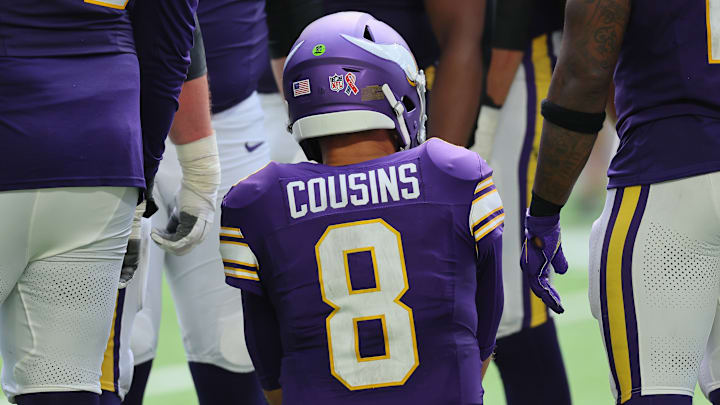The Minnesota Vikings hit a major turning point when Kirk Cousins signed with the Atlanta Falcons in free agency this offseason. Cousins represented a rare level of stability for the Vikings at quarterback, as he spent six seasons in Minnesota and left ranking toward the top in many of the franchises' notable statistical categories.
Cousins’s success in the record books made it hard to say goodbye, and several fans were loyal until he signed a four-year, $180 million contract with the Falcons on March 13.
While Cousins was everything you wanted in a starting quarterback, he also carried some baggage, which left the Vikings with no choice but to let him walk.
So why did it make sense for Minnesota and Cousins to part ways, and how does his departure open up a new world of possibilities moving forward?
3 biggest reasons why the Minnesota Vikings had to part with Kirk Cousins
1. Kirk Cousins’s Achilles injury was a major risk
One of the biggest arguments for Cousins was his ability to stay on the field. Cousins only missed one start in his first five seasons with the Vikings, and it was the only game he sat out due to injury until he tore his Achilles in an October 29 win over the Green Bay Packers.
Cousins made sure to make note of this during his free agency tour, telling everyone who would listen that he was a pocket passer. Because of his tendency to stay in the pocket, his limited mobility wasn’t as much of a detriment as it would be to a scrambling quarterback, but that is flawed logic.
Dan Marino tore his Achilles during Week 6 of the 1993 season but returned to throw for 4,453 yards and 30 touchdowns in 1994. Marino wasn’t the same quarterback when he returned, however, as his yards went from 7.2 air yards per attempt in the first 11 years of his career to 6.6 air yards per attempt in the final six years of his career.
While personnel was some of the reason Marino’s numbers declined, his lower body strength wasn’t the same after the injury, causing a decline in arm strength. Medicine has advanced to help athletes return faster from Achilles injuries but there has yet to be a true comeback story – especially for a player that will turn 36 in August.
With questions about how Cousins would come out on the other side, signing Cousins was a big gamble, especially when you consider how much it took to bring him in.
2. Kirk Cousins’s market became too rich for the Vikings
If the Vikings wanted to reach a deal with Cousins, the perfect time was after the 2022 season. Cousins had just led the Vikings to a 13-3 record and their first division title since 2017. With eight fourth-quarter comebacks and a Kirko Chainz persona that was working its way into the hearts of the fan base, Cousins had all the power going to the negotiating table until the Vikings balked at his cost.
According to the Star Tribune’s Andrew Krammer, Cousins was willing to take less money per year but also wanted guarantees through the 2025 season. With the Vikings wanting to maintain their flexibility in the future, they didn’t reach a deal and Cousins was focused on hitting the market this spring.
It was a calculated risk by Cousins, and it looked like it wouldn’t pay off when he got hurt last October. But NFL teams are desperate to find a solution at the quarterback position and are often willing to overpay if they feel they’re in a position to win the Super Bowl.
It happened when Cousins signed his initial contract with the Vikings in 2018, getting the first fully guaranteed contract in NFL history. While this contract wasn’t fully guaranteed, it was still $45 million per season, which would have taken a large chunk out of the Vikings’ cap space.
With Cousins gone, the Vikings were able to use that money to shore up the defense with Jonathan Greenard, Andrew Van Ginkel and Blake Cashman and have $106.4 million in cap space in 2025 according to Over The Cap.
3. Kirk Cousins no longer fits the Vikings’ timeline
When the Vikings signed Cousins in 2018, they were a team that felt like they were one player away from the Super Bowl. But when the roster turned over after Cousins’s first playoff win in 2019, the supporting cast around Cousins started to disappear.
Not all of this was Cousins's fault, as general manager Rick Spielman’s hit rate in the draft declined, and Mike Zimmer’s ability to develop young players also deteriorated. But Cousins’s salary also limited their ability to fill holes in free agency, sending the Vikings into a 7-to-9 win purgatory.
There’s value in making the playoffs every year, but the Vikings were never good enough to be a real contender. When Cousins told reporters his desire to win before the ill-fated “hometown discount” line, it seemed to signal the end.
The Vikings are a team that needed fresh blood and Cousins needed a team that was ready to win now. While Minnesota could wind up with the same amount of wins without Cousins, they have too many needs to win with him.
That left Cousins’s best option with Drake London, Bijan Robinson, and Kyle Pitts in Atlanta and the Vikings to pick up the pieces and move on.
